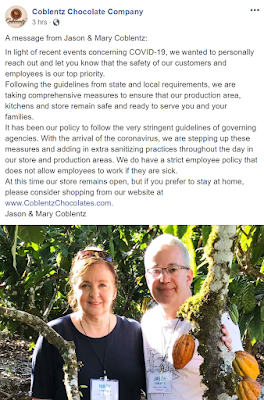There’s nothing
quite like homemade marshmallow. If you don’t make your own marshmallow, now is
the time to experiment with recipes and techniques. This week, we’re offering expert
tips for cutting, dusting, enrobing and packaging marshmallows. Plus, a bonus marketing idea!
Boiling Corn
Syrup
This tip will
help prevent chocolate-covered marshmallows from cracking. Here’s why: most 42
DE (dextrose equivalent) corn syrup contains a small amount of yeast bacteria. This
is a common problem with marshmallows, because the corn syrup is added to the sugar
slurry (or bob) after it has been removed from heat, so it doesn’t get warm
enough to eliminate any yeast found in the corn syrup.
The solution, bring
corn syrup to a very low boil. Just as it begins to boil, remove it from heat.
Do this step early in the day, allowing it to cool to room temperature before adding
it to the cooked portion of the marshmallow. A fellow candy maker did this and
never had a cracked Easter egg again.
Cutting
When cutting
small batches of marshmallow, RCI members have recommended the following ways
to be most efficient:
- A guitar cutter works, but it really depends on how soft your marshmallow recipe is. As an alternative, a sharp pizza cutter works well too. – J. Sofia, Cargill Cocoa & Chocolate
- We use a lightly buttered, sharp, thin-bladed knife. [We re-apply the butter] every 2 or 3 rows. It's a bit slow, but eliminates the need for corn starch, which I found made the marshmallows difficult to coat. –W. Spence, Spence Candies
Dusting
Dusting marshmallows is an
important step to preserve that soft and pillowy texture that we desire.
Traditionally candy makers use powdered sugar or corn starch to keep
marshmallows from drying out and becoming hard. Aside from the cloud of dust
they leave everywhere, a coating of powdered sugar can make your already sweet
marshmallows too sweet and corn starch can make it difficult for chocolate to
stick to the marshmallow.
As an alternative to the
traditional corn starch and powdered sugar, try replacing them with dextrose or
fondant sugar (such as Amerfond® Fondant Sugar).
Both products will help you achieve the desired affect and with less the mess.
For marshmallows bound for the enrober, adding a little
dextrose to the top and bottom will also help the chocolate stick.
Enrobing
If air bubbles are a problem when
enrobing square confections, like marshmallows, send them through your enrober
corner first. Your products will receive better chocolate coverage from the
fountains on the enrober and you will decrease the chance for bubbles to appear
on the tops.
Packaging
Have you ever
noticed condensation (or worse, mold) on the inside of your marshmallow
packaging? If so, you may be cutting and packaging your marshmallows too soon. Of
course, you want your marshmallows to be as fresh as possible, but marshmallow
needs to breathe for a while or else the warmth may create moisture and you may
experience mold on your product. A general rule of thumb is to let marshmallow
sit overnight before cutting, dusting and storing it.
Marketing Your
Mallows
While people are
spending more time at home, share ideas for gourmet s’more recipes that your social
followers can make at home with your products. Click
here for 5 creative s’more ideas. Package your fresh, homemade
marshmallows, along with your chocolates and graham crackers, and sell as a
fun, family activity to make together at home.
If you’ve ever
questioned whether making your own marshmallow is worth the hassle, these
expert tips will not only make your job easier, they will leave your customers
wanting more of these fluffy confectionery wonders!
Crave more? If
you like what you read here, look for the "Subscribe now" box
on the right to enter your email address and start receiving weekly tips, like
this, delivered straight to your email inbox. RCI's Tip of the Week blog is
just one of the many resources we offer to help candy makers refine their
craft and build upon their business and marketing practices.











